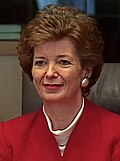Labour and the Workers' Party
In January 1990, Labour leader Dick Spring stated his belief that the Labour Party needed to run a serious candidate in the election and that if no other candidate could be found, he himself would run. [2]
The first viable candidate Labour sought was Mary Robinson; with her background in both the Seanad and her legal work, both of which saw her fighting for causes such as women's and minority rights, Robinson seemed to have excellent credentials for the role of President. However, a major stumbling block towards recruiting Robinson was her reluctance to rejoin/reaffiliate with the Labour Party. [d] This delay in the recruitment of Robinson allowed for a second contender to emerge in the Labour camp: Noël Browne. [2]
Noël Browne was a politician who had first emerged into Irish politics as a member of Clann na Poblachta and a Minister for Health in his first term as a TD as part of the first inter-party government of 1948. Browne was initially lauded for his successful crusade against tuberculous in Ireland, but his plan to introduce the Mother and Child Scheme was a major component in bringing down the government. From that time on, Browne was a persistent figure in Irish national politics but frequently found himself unable to integrate himself into party politics. After moving through a number of parties in the 1950s and 1960s, Browne was part of Labour for 14 years between 1963 and 1977. He left the party in a dispute over forming a formal electoral alliance with Fine Gael.
Spring's announcement in January had piqued Browne's interest and that of his supporters (which included Labour members such as Michael D. Higgins and Emmet Stagg). They quickly moved to explore options for how Browne could stand in elections, which led to Browne having an inconclusive meeting with the Workers' Party at the end of January. Browne's manoeuvring caught the attention of the Irish news media, who began to openly speculate about the prospect of a Browne candidacy, almost to the exclusion of Robinson. On 26 March, Browne was able to secure the endorsement of the Labour Women's National Council, a sub-organisation within the Labour Party with former ties to Robinson. [2]
However, the Spring–Robinson talks continued to progress in parallel to Browne's movements, and on 4 April, Spring held a meeting of the Parliamentary Labour Party to discuss each candidate. A vote proposing Noel Browne as Labour's candidate was defeated by a 4 to 1 ratio, while a subsequent vote proposing Robinson succeeded. [2]
Browne was bitterly disappointed to not receive the nomination and would for the remainder of his life hold a caustic view of Robinson. [2] [4] [5] Nevertheless, it has been suggested that many of his supporters transferred their allegiance to Robinson once she became Labour's nominee and that they were a key component in her campaign. [2]
Although Robinson had secured the Labour Party's nomination, she was not yet eligible to contest the election as the Labour Party, with 15 TDs and 4 senators, was short of the support of 20 members of the Oireachtas was required to enter the race. In order to secure the final signatures required, the Labour Party worked together with the Workers' Party, who had 7 TDs.
By May 1990, Robinson was the formal joint Labour and Workers' Party nominee, and the first candidate to enter the race. [6]
Fine Gael
At the 1990 Fine Gael Ard Fheis, party leader Alan Dukes promised that he would find a "candidate of vigour and stature" to contest the election. However, Dukes had great difficulty in trying to secure a candidate from his party's ranks, primarily due to their perception that Fianna Fáil's Brian Lenihan would be a runaway favourite to win. [7] Dukes attempted to secure the candidacies of former Taoiseach Garret FitzGerald and former Tánaiste Peter Barry but failed. [8]
With his options dwindling, Dukes turned to the newly elected TD Austin Currie. Currie had entered the Dáil for the first time 15 months previously following the 1989 general election. However, Currie had an extensive background as a political activist in Northern Ireland as part of the civil rights movement in Northern Ireland and as a former member of the Social Democratic and Labour Party.
After Dukes convinced Currie to stand, [9] Currie's nomination was confirmed by a unanimous vote of Fine Gael's parliamentary party on 12 September. [7] [10] By that point, it was already well known to the public that Brian Lenihan would be frontrunner for the Fianna Fáil nomination. [10]
Failed Independent bid by Carmencita Hederman
On 15 October (the day before the nomination deadline) recently elected Senator and former Lord Mayor of Dublin Carmencita Hederman asked Dublin City Council to support her and to give her a nomination towards the presidency. [1] However, the motion was defeated by 31 votes to 5. Councillors from Fianna Fáil, Fine Gael, the Progressive Democrats and the Workers' Party cited that they could not support her bid, as their parties had already given their support to other candidates or ruled themselves neutral. [1] Hederman's bid was supported by Independent TDs such as Tony Gregory and Seán Dublin Bay Rockall Loftus as well Green TD Roger Garland. [1] Hederman did not petition any additional councils following her failure to secure a nomination from Dublin City Council. [14]
Hederman asserted on 15 October that the Progressive Democrats had promised to support her bid contingent on her securing 20,000 signatures of public support, but pulled their pledge at the last moment. Mary Harney denied this, and stated she had told Hederman her support was contingent on Hederman securing the backing of 11 other TDs. Ultimately, the Progressive Democrats declared "neutrality" in the election, and did not officially support any candidate. [1]










